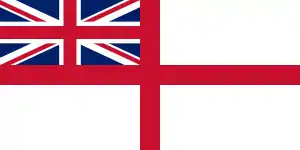Royal Navy Surface Fleet
The surface ships of the Royal Navy form one of the fighting arms which is administered by the Commander United Kingdom Strike Force and Rear Admiral Surface Ships (COMUKSTRKFOR) (CSF)).[1][2] Commander United Kingdom Maritime Forces is a sea-going combatant command appointment. Surface ships form one of the five fighting arms of the Royal Navy.[3]
| Commander United Kingdom Strike Force and Rear-Admiral Surface Ships | |
|---|---|
 | |
| Active | Maritime Forces: 2001–current |
| Country | United Kingdom |
| Branch | Royal Navy |
| Type | Military branch |
| Size | Command |
| Garrison/HQ | Portsmouth, England |
| Commanders | |
| Current commander | Rear Admiral Michael Utley |
History
During much of the medieval period, fleets or "king's ships" were often established or gathered for specific campaigns or actions, and these would disperse afterwards. These were generally merchant ships enlisted into service. Unlike some European states, England did not maintain a small permanent core of warships in peacetime. England's naval organisation was haphazard and the mobilization of fleets when war broke out was slow.[4] In the 11th century, Aethelred II had an especially large fleet built by a national levy.[5] During the period of Danish rule in the 11th century, the authorities maintained a standing fleet by taxation, and this continued for a time under Edward the Confessor, who frequently commanded fleets in person.[6]
Royal Navy surface ships currently consist of two flotillas based at HMNB Portsmouth and HMNB Devonport, both located on the south coast of England. Surface combatants range from aircraft carriers to mine countermeasures vessels to offshore patrol vessels, but most are escorts; destroyers (Type 45) and frigates (Type 23).
Surface combatants deploy to conduct several permanent Standing Royal Navy deployments. Closer to home, the surface fleet also conducts Fishery Protection Patrols around UK waters, by agreement with the Department for Environment, Food and Rural Affairs (DEFRA).
At some point between 2011 and 2018, Commander United Kingdom Maritime Forces and Rear Admiral Surface Ships was also given the role of Rear-Admiral Surface Ships, the 'tribal chief' of surface ships within the Navy. Commander United Kingdom Carrier Strike Group and Commander Littoral Strike Group are the two main 1* deployable forces under COMUKMARFOR.
Current surface ships
See also
- History of the Royal Navy
- List of active Royal Navy ships
- Standing Royal Navy deployments
Footnotes
- "Rear Admiral Andrew Burns OBE Commander UK Maritime Forces and Rear Admiral Surface Ships" (PDF). royalnavy.mod.uk. Royal Navy. Ministry of Defence. UK. Retrieved 10 June 2019.
- "Surface Fleet". royalnavy.mod.uk. Royal Navy. 24 December 2019. Retrieved 24 December 2019.
...was appointed Commander United Kingdom Maritime Forces COMUKSTRKFOR (CSF) and Rear Admiral Surface Ships (RASS)
- "THE ROYAL NAVY'S SURFACE FLEET" (PDF). royalnavy.mod.uk. MOD UK. Retrieved 5 August 2018.
- Rodger, Safeguard, pp. 52–53, 117–130.
- Swanton, p. 138.
- Swanton, pp. 154–165, 160–172.
Sources
- Brown, David (1987). The Royal Navy and Falklands War. Barsley, England: Pen and Sword. ISBN 9781473817791.
- Mackie, Colin (August 2018). "Royal Navy Senior Appointments from 1865". gulabin. C. Mackie.
- Roberts, John (2009). Safeguarding the Nation: The Story of the Modern Royal Navy. Barnsley, England: Seaforth Publishing. ISBN 9781848320437.
- The Navy Directory: (2017) KEY PERSONNEL: Seniority Lists of Officers on the Active List. (PDF). royalnavy.mod.uk. MOD, UK.
- Dr Graham Watson, Royal Navy Organisation And Ship Deployments 1947–2013